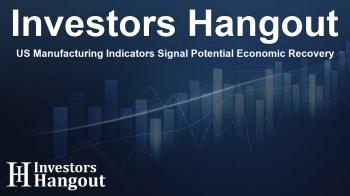US Manufacturing Indicators Signal Potential Economic Recovery

Manufacturing Sector Shows Signs of Expansion
The Institute of Supply Management (ISM) Purchasing Managers Index (PMI) recently reported a figure of 50.9 for January. This reading notably surpasses analysts' expectations, which were set at 49.3. It marks the first expansion in the manufacturing sector in over two years, signaling a potential turnaround in economic activity.
Recent Historical Context
The last significant reading at this level dates back to September 2022, indicating considerable shifts in market conditions. January’s results reflect a 1.6 point increase compared to December, representing the third consecutive month of growth for the PMI. Encouragingly, 8 out of 18 manufacturing industries have reported growth.
Comments from Industry Panelists
“U.S. manufacturing activity expanded in January after 26 consecutive months of contraction. Demand clearly improved, while output expanded and inputs remained accommodative. Demand and production improved; and employment expanded. However, staff reductions continued with many companies, but at weaker rates. Prices growth was moderate, indicating that further growth will put additional pressure on prices.”
This statement from industry experts underscores a notable change in the overall feel of the manufacturing environment, with improvements highlighted in demand and output alongside rising employment metrics.
Key Sub-Components of the Index
The PMI is composed of several critical sub-components that can help predict future growth in manufacturing: new orders, production, and employment. In January, new orders increased significantly from 52.1 to 55.1, with 9 industries reporting growth, indicating a robust demand shift.
Positive Trends in Production and Employment
“Panelists noted an improved level of demand performance, with a 2-to-1 ratio of positive comments versus those expressing concern about near-term demand, an improvement compared to December.”
Furthermore, the production index showed a positive shift, moving from 49.9 to 52.5, breaking eight months of contraction with six industries reporting increased production levels. The employment index also made a significant improvement, rising from 45.4 to 50.3, marking a turn after 14 months of decline, although only four industries indicated growth.
Rising Prices Bring Mixed Signals
Conversely, there has been an uptick in the prices paid index, climbing from 52.5 to 54.9. This increase points toward 11 industries facing higher costs for raw materials, which could pose a challenge if prices do not stabilize.
The Bigger Picture
The manufacturing sector has faced several difficulties, lingering in contraction territory for an extended period. However, stabilizing above a contraction threshold suggests a possible recovery phase. Observations show that moving back into growth is essential, as manufacturing represents a considerable portion of the US economy.
Yet, it's crucial to maintain perspective; one month's data should not be seen as an indicator of a sustained trend. Previous close calls, like in March, showcased the sector's fragility as it slipped back into contraction. The historical average PMI level is around 52.6, indicating that there is still room for improvement.
With all three main subcomponents—new orders, production, and employment—registering above the pivotal 50 mark signifies positive momentum. Should the prices paid index reflect declining figures, this would further reinforce the potential growth narrative.
Conclusion
In summary, while the PMI results for January spotlight encouraging growth signals, industry stakeholders should approach these developments with cautious optimism. Monitoring market trends in subsequent months will be essential to determine if this is the beginning of a more comprehensive recovery in the manufacturing sector.
Frequently Asked Questions
What does a PMI reading above 50 indicate?
A PMI reading above 50 signifies expansion in the manufacturing sector, while readings below 50 indicate contraction.
How does the recent PMI compare to historical trends?
The recent PMI of 50.9 is the highest reading since September 2022 and indicates a positive shift after 26 months of contraction.
Which sub-components of the PMI showed growth in January?
New orders, production, and employment all exhibited growth, reflecting an overall improvement in demand and output.
What challenges does the manufacturing sector currently face?
The sector is experiencing rising costs for raw materials, which may pressure profitability if not managed effectively.
Why is it important to analyze PMI trends over time?
Analyzing PMI trends helps predict economic conditions and potential growth or contraction phases within the manufacturing industry.
About The Author
Contact Dylan Bailey privately here. Or send an email with ATTN: Dylan Bailey as the subject to contact@investorshangout.com.
About Investors Hangout
Investors Hangout is a leading online stock forum for financial discussion and learning, offering a wide range of free tools and resources. It draws in traders of all levels, who exchange market knowledge, investigate trading tactics, and keep an eye on industry developments in real time. Featuring financial articles, stock message boards, quotes, charts, company profiles, and live news updates. Through cooperative learning and a wealth of informational resources, it helps users from novices creating their first portfolios to experts honing their techniques. Join Investors Hangout today: https://investorshangout.com/
The content of this article is based on factual, publicly available information and does not represent legal, financial, or investment advice. Investors Hangout does not offer financial advice, and the author is not a licensed financial advisor. Consult a qualified advisor before making any financial or investment decisions based on this article. This article should not be considered advice to purchase, sell, or hold any securities or other investments. If any of the material provided here is inaccurate, please contact us for corrections.

